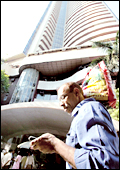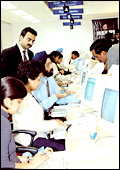 |
| D-street: Standing tall, but for how
long? |
If
you missed out on the 10k rally, sit back, relax and understand
that you missed the boat. Cruising in the stratosphere above 10k
(the market closed at 10,626.78 on March 2), Dalal Street shows
few opportunities to make money anymore. There's little upside
left, say experts, but not everybody agrees. Restless investment
managers are betting on a further rise, on the back of FII inflows,
which have now touched Rs 1,84,560 crore since the early 90s,
of which 60 per cent (about Rs 1,16,000 crore) has come in the
past three years.
So, is the market over-heated? Although experts
say The Street is reasonably valued today, there are others who
point out that we could see a difference in coming days. "Demand
(from investors) is expected to outstrip the supply (of stocks)
in future," warns Girish Nadkarni, COO, IL&FS Investsmart.
But let's first look at the concept of valuation
itself. Basically, valuation is the process of determining a company's
worth. One way of doing this is to compare the company's ruling
stock price with how much each share has earned, that is, the
earnings per share. This is called the price-earnings or p-e ratio.
When a company's P-E is high, the market is obviously willing
to pay much more for the stock, expecting even better days ahead.
And, either the stock has to live up to those earnings expectations
or see its price come crashing down.
While the p-e ratio alone
is hardly a comprehensive overview of the stock, it's a useful
number that indicates if the stock is under-valued, fairly valued
or over-valued. Today, corporate earnings are growing at over
15 per cent, while P-E ratios are also reigning at similar levels,
which is why experts conclude that this market is a fairly valued
one.
There is, however, reason to expect volatility.
According to S. Naganath, President & Chief Investment officer,
DSP Merrill Lynch, there is a possibility of P-Es climbing higher,
given the vast liquidity coming in from foreign shores. "That
possibility cannot be ruled out, in view of the robust growth
in the Indian economy," says Naganath, hinting that even
if the earnings growth slows down, the p-e escalation could push
the market north.
That's what happened during the Harshad Mehta
bull run of 1992, when the market p-e soared to 50, or during
the more recent tech-driven Ketan Parekh rally of 1999-2000, when
P-Es touched 25, both times without a corresponding earnings growth.
Even as P-Es rule at 17-18 in the present
rally, there is the possibility that they will spiral up. And
fund managers and investors are worried that earnings growth could
simultaneously plummet due to high oil prices and steeply rising
global interest rates. Undoubtedly, maintaining earnings growth
will be the most challenging task in 2006-07 for corporate India,
though Naganath is optimistic: "We feel the corporate sector
can maintain an earnings growth of 15 per cent CAGR in the next
15 years."
On the other hand, rising global interest
rates will affect short-term inflows from hedge funds and also
impact domestic consumption behaviour. As S. Ramesh, Executive
Director, Kotak Mahindra Capital, says: "The key risks to
the markets remain continuing corporate performance and rise in
global interest rates, which could result in outflow of funds
from the markets."
 |
 |
 |
Experts advise
sectoral rotation and are bullish about IT,
banking, oil and capital goods, which stayed out of the 10k
limelight in the past year |
Another possibility: a reviving debt market
may see the portfolio mix of hedge funds and institutional investors
changing; while domestic MFs diversify into debt in their close-ended
and tax-saving schemes.
Factoring all this in, it's clear that it's
not going to be all roses on Dalal Street from here on, which
makes life fairly uncertain for the small investor. Which is why
we present here a post-10k investment strategy for you.
Go For Equity
World over, equity as an asset class has
given superior returns in the long term compared to debt, gold,
real estate or other avenues. With the market peaking at 10k in
just over three years, valuations certainly look expensive but
if one has a long-term horizon-three to five years or five to
10 years-there's ample scope for earning decent gains. And you
could look at about 15 per cent returns (annualised) over that
period.
Try Sectoral Rotation
Experts advise sectoral rotation. For instance,
the fast moving consumer goods (FMCG) sector has bounced back
after being down in the dumps for many years. In fact, the FMCG
index (over a dozen companies) has outperformed the Sensex in
the last one year. Similarly, look at sectors like oil, pharma,
it, public sector undertakings and metals that have stayed away
from the 10k limelight in the past year. "I'm bullish about
capital goods, real estate and construction, it, BPO services
and banking. If the economy expands, these sectors will do well,"
says Ramesh.
Review Overpriced Sectors
"Valuations are a bit high in engineering
and capital goods," observes Girish Nadkarni," COO,
IL&FS Investsmart, but it could be worth it. As Asit Koticha,
MD and CIO, ask Raymond James, says, engineering and capital goods
might look expensive in relative terms, but their super growth
potential of 35-40 per cent makes them attractive investments.
"Massive investments are planned in roads, airports, ports
and power, and that will keep this sector busy over the next three
to five years," says Koticha.
Follow A Bottom-up Approach
Following a sector story doesn't mean doing
so blindly just because it has underperformed or looks promising
for the future. Your stock-picking strategy should be to pick
value at every fall in the market. "One could look at past
performance in recent quarters, expansion plans, funding mix,
management reputation and price history," advises a fund
manager.
Go For Mutual Funds
MFs are the ideal vehicle if you don't have
the time or patience to track the market. Rookie investors should
take the systematic investment plan (sip) route into equity to
neutralise market fluctuations over the long term. Typically,
a long-term investor should choose a close-ended scheme so that
he can experiment with debt as well as mid-cap stocks. "Investors
looking for short-term stay in a mf can buy diversified equity
funds in infrastructure, services and mid-cap areas," says
the CEO of a MF.
INTERVIEW:
SUSHIL MUHNOT/MD/IDBI Capital Market Services
"There Is Still Potential To Make Money in the Market"
IDBI
Capital Market Services is upping its presence in retail equity
after many years of focus on institutional investors. Managing
Director Sushil Muhnot,
who is aggressively building a strong franchise model for retail
trading, spoke to BT about 10k and the road ahead for small
investors. Excerpts:
From 3K levels in Jan 2003, the market
has skyrocketed to 10K in a little over three years. Is there
still scope for making money in the market?
At 10k, the market looks reasonably valued.
In fact, if you look at the run-up from 9k to 10k, the rally was
driven solely by front line stocks. Therefore, there is still
potential to make money in the market. Investors getting in at
this level into mid-caps should look at the three-five year track
record of the company and sector financials and management history
before putting their money in.
Is the sectoral story over now?
Some sectors like cement, sugar, tea and auto-ancillaries
have been buoyant in the last couple of months. Investors should
note that the long-term direction is clear-the focus is on agriculture,
small and medium enterprises and infrastructure. For instance,
any sops for agriculture will directly aid sectors like pesticides,
seed, tractors, and agriculture equipment companies.
Is there enough good quality paper coming
into the market for small investors?
If you have a good secondary market, the primary
market follows suit. We have seen good quality IPOs from across
sectors. In oil and gas, most companies are public sector, where
there is a possibility of disinvestment. I see more construction
companies entering the market. But I would advise investors to
avoid small issues that don't have a good management or performance
track record.
What kind of returns should one expect
from these levels?
If you follow prudent investment norms, and
stay a bit longer- maybe a year-you can expect about 15 per cent
returns from this market.
Not So Healthy
With public sector insurers wanting to tweak
medical cover, it bodes ill for customers.
By Nitya varadarajan
 It's
about a decade now since the public sector general insurance companies
launched Mediclaim or individual health policies. And, as if to
celebrate the anniversary, they are suddenly upping the ante on
Mediclaim. It's
about a decade now since the public sector general insurance companies
launched Mediclaim or individual health policies. And, as if to
celebrate the anniversary, they are suddenly upping the ante on
Mediclaim.
For starters, they want the premium slabs,
which they say haven't been touched in years, revised. A senior
industry official says that he would like premiums hiked by 40
per cent. It's another story that policyholders have actually
been paying 6 per cent more on premium during the last three years
to cover third-party administrator service costs.
The second major change proposed is to insist
on family cover. Individuals per se are to be denied cover unless
they insure all family members for a uniform sum. Third, companies
want to increase the minimum cover from Rs 15,000 to Rs 50,000-1,00,000.
Insurers would also like to load premiums
for senior citizens by 100 per cent, over and above the actual
rate applicable (whether or not they have had claims outgo), or
discontinue their policy. Other proposals include introducing
caps or sub-limits on hospitalisation expenses like room rent,
surgeon's fee, or medicines, while raising the maximum sum insured
to Rs 1 crore from the present Rs 5 lakh. And making pre-approval
health checks mandatory for all age groups. In fact, insurers
have already incorporated many of these measures quietly.
ALARMING WISHLIST
The changes insurers would love
to see in Mediclaim: |
»
Premium slabs to be hiked, perhaps by as much as
40 per cent
» No more
individual cover; entire family must buy cover for uniform
sum
» Minimum
cover to be increased from Rs 15,000 to Rs 50,000-1,00,000
» Senior
citizen premiums to be loaded by 100 per cent
» Maximum
sum assured to be raised to Rs 1 crore from the present Rs
5 lakh
» Sub-limits
to be introduced for expenses like room rent, medicines, or
surgery fees
» Pre-approval
health checks to be mandatory for all age groups |
According to the IRDA (Insurance Regulatory
and Development Authority), these measures have not yet been submitted
as a formal proposal. It has asked public sector insurers for
the rationale behind the proposals, saying that they are tantamount
to changing the face of the coverage. If IRDA does not sign off,
then consumers can heave a sigh of relief.
So, why are insurers feeling so bloody-minded?
The health portfolio of all insurance companies (and public sector
insurers have an 80 per cent share of the health cover market)
incurs heavy losses due to a very high claims ratio. Claims outgo
losses are roughly 130 per cent (which, however, does not factor
in the income from investment returns on the total premiums of
Rs 1,400 crore). Companies now want higher premiums and stringent
underwriting to counter this.
Much of the loss, however, arises because
of the heavy discounts offered by insurers to companies on corporate
group health plans, mostly in order to sell lucrative packages
for fire and property covers. Corporate policies have low premiums
and offer wide benefits, like coverage of pre-existing diseases,
maternity costs and floater covers for families (additional members
covered at 10-20 per cent extra). Admits a spokesperson from Cholamandalam
ms General Insurance: "Group policies offer a lot of concessions
and the cross-subsidisation (by individual policies) is proving
inadequate."
If these changes are allowed to take shape,
Mediclaim in its present form will probably become prohibitively
expensive, and its place taken by a host of smaller policies for
various conditions. Says a United India official: "Mediclaim
(as it is) will continue, but will gradually be phased out."
The private sector could follow suit. Or new health insurance
companies waiting in the wings could bottom out rates and give
public sector insurers a run for money.
Already, private companies like Cholamandalam
(who have no plans to hike rates) offer value-adds that should
make public sector insurers sit up. For instance, Chola has separate
low premiums for people under the age of 18, and if a policyholder
has not been hospitalised for a disease for two years before taking
the policy, Chola does not treat it as a pre-existing condition.
Besides, the company has negotiated with 3,000 hospitals for lower
rates for its policyholders.
With other private players also aggressively
marketing their health covers, public sector firms will increasingly
find the going tough enough without making polices more customer
unfriendly. In fact, if these firms care to go back in time, they
did have sub-limits on policies about a decade ago, but the queues
for grievance redress grew so long that this had to be dropped.
Reintroducing this, and the other proposals, could set dissatisfied
customers on the warpath again.
AROUND THE WORLD ON EMI
Travel never looked easier. Just book your
tickets and pay over the next three years.
By Anand Adhikari
 Athree-country
Europe tour for an EMI (equated monthly instalment) of Rs 2,982,
for a couple with a 12-year-old kid. The offer comes from SOTC
India, in association with its exclusive bank partner Kotak Mahindra. Athree-country
Europe tour for an EMI (equated monthly instalment) of Rs 2,982,
for a couple with a 12-year-old kid. The offer comes from SOTC
India, in association with its exclusive bank partner Kotak Mahindra.
The seven-day tour takes the family to Switzerland,
Austria and Italy, and costs Rs 86,000, which covers air fare,
accommodation, food and sightseeing. Sounds good?
SOTC is not the only company offering such
attractive packages, as the travel industry woos customers with
an array of offers. From Cox and Kings to Raj Travels to Kesari
Tours, tours on EMI are getting popular. "Foreign tours are
now well within the reach of the middle class. Rising income levels
and attractive discount offers from tour operators are helping
the industry," says Himanshu Patil, Director, Kesari Tours.
As the average Indian's spending power has
gone up, so too has his interest in overseas travel and the willingness
to shell out money. Obviously, it helps that easy loans are up
for grabs. Interest rates for travel agent loans are 7.5-11.25
per cent and, as Arup Sen, Executive Director, Cox & Kings,
says: "The market has matured. People no longer have reservations
about taking a loan for a holiday. This was something that was
unheard of even, say, 10 years ago."
Realising the potential, fund-flush banks
have also jumped into the fray, and are promoting travel loans,
especially as the margins are higher compared to housing, auto
or other mortgage loans. Then, of course, there are the bank personal
loans that can be used for travel. However, interest rates here
are slightly higher-10.5-14.5 per cent.
Take a look at the loans from travel agents.
"The documentation process is much speedier. You can avail
a loan within a maximum week's time," says Patil. Cox &
Kings offers a loyalty bonus in the form of a pre-approved loan
from a bank for any traveller who has travelled with them in the
last three years. Says Sen: "Documentation is minimum. We
need the last salary certificate, bank account details, etc. The
processing is quick and the passenger gets his loan in 48 hours."
A Kotak Bank officer sits in the SOTC office
to guide the prospective traveller and tell him how much EMI he
has to pay, the interest rate, the loan duration and other loan
details. "It's quicker getting a loan than a visa,"
says a SOTC official. In rare cases, travel companies or banks
ask for your payment track record on a credit card, personal loan,
car or home loan, along with your income documents. "Today,
20 per cent of the travellers who approach us opt for EMI schemes,"
says Patil.
With three sources of travel loans, how do
you decide which to choose? Each has its advantages and disadvantages.
For instance, the travel agent works through exclusive bank partners
who offer shorter repayment schedules-12-36 months-compared to
the banks' standalone travel or personal loans, where repayment
periods could be 48-60 months from some banks. Travel agents,
however, are a one-stop shop for both loan and itinerary. Then,
although EMIs are reasonable for travel agent loans, there is
the compulsion of being tied into a package tour with little flexibility.
"The advantage is that you can see the
world at such a reasonable price," says Sen. So, for instance,
there's a Cox & Kings tour costing Rs 89,999, where the EMI
works out to Rs 3,186 per month for a 36-month tenure. And for
its domestic holidays, called Bharat Deko packages, EMIs start
from Rs 1,120 per month for 36 months. For the first time, the
middle class person can afford to travel, and by the time he repays
the loan (in three years), he is ready for the next holiday.
On the other hand, you have bank travel loans
like the Desh Videsh Yatra from Bank of Baroda. At 10.50 per cent
interest and a repayment schedule of 36 months, it's very competitive.
Plus, loan amounts are flexible, ranging from Rs 25,000 to Rs
10 lakh. However, you do need a third-party guarantor for loans
above Rs 2 lakh. The advantage here is that you can make your
own schedules, select the hotels and travel alone. With a loan
like SBI's Easy Travel Loan, you also get a long repayment tenure
of four years. The interest here is 12.75 per cent for a Rs 24,000-Rs
2.5-lakh loan.
Bank personal loans offer even better tenures,
ranging from 48 months to 60 months, but the loans themselves
are expensive. ICICI Bank offers the longest repayment schedule
of 60 months, with loan amounts ranging from Rs 20,000 to Rs 15
lakh, but interest rates are 14-18 per cent. You don't, however,
require security or collateral.
As competition hots up, soon airlines and
hotels too could hitch their wagons to the EMI star. Clearly,
it's time to pack your bags.
The Churning
Pot
Constantly pulling out money to invest in
new schemes might give short-term gains, but what about long-term
capital growth?
By Anand Adhikari
 |
"Churning is driven by investors'
need to book profits at every rise"
Naval Bir Kumar
MD, Standard Chartered Asset Management Company |
Sandesh
Pathak, 30, works for a UK-based BPO. From early 2005 till date,
on his mutual fund (MF) distributor's advice, Pathak has pulled
out his money from existing schemes and invested in new fund offerings
(NFOs) four times over. The result? Pathak's Rs 50,000 is Rs 1
lakh.
At first sight, Pathak's 'churning' strategy
appears great. In fact, as our story on NFOs shows (see A Siren
Song), investors have made solid money from NFOs. The question
is, at what cost? What investors like Pathak don't realise is
the tremendous pressure churning puts on fund managers and other
small investors who are in the scheme for the long term. Churning
goes against the basic principle of MFs-long-term capital growth.
Says Naval Bir Kumar, Managing Director (MD), Standard Chartered
Asset Management Company: "It's driven by investors' drive
to need profits at every rise."
And who gains the most? No prizes if you
said distributors. "Every NFO application gets us a commission,
whereas equity IPO commissions are subject to allotment,"
says a distributor. In fact, the commission on mf equity schemes
is much higher than that on other investment classes like debt,
equity IPOs, bonds, etc.
And then there are the incentives for exceeding
NFO targets. Last June, SEBI Chairman M. Damodaran regretted that
new schemes were being driven by rebates and incentives at the
cost of investor interest. Sushil Muhnot, MD, IDBI Capital Market,
defends distributors: "We sell mf schemes based on product
attributes and individual needs."
However, SEBI remains serious about regulating
distributors and is making MFs responsible for the former. Its
code of conduct for intermediaries forbids commission-driven malpractices
such as recommending products solely because of higher commissions;
or encouraging over-transacting of investments to earn higher
commissions at the cost of investors paying higher transaction
fees and taxes.
Meanwhile, fund houses themselves are launching
a barrage of new schemes, making no effort to market existing
ones. "New schemes, higher commissions and foreign junkets
are the private sector way of growing assets under management
(AUMs)," says the CEO of a public sector mf.
How can the phenomenon be discouraged? "You
can increase the exit load (presently 1-2.5 per cent)," says
a fund manager. However, as Kumar points out, returns are high
enough to take care of the exit load cost. Some experts suggest
making all schemes close-ended, as the only way to develop a long-term
investment cult in the industry.
Right now, funds don't seem inclined to listen
in the mad rush to increase assets under management.
NEWS ROUND-UP
Mid-rung Pharma Starts Climbing
 The
focus on contract research and manufacturing (CRAM) and on building
scale through inorganic growth has helped boost mid-tier pharma
companies like Divis Laboratories, Matrix Laboratories and Nicholas
Piramal. Analysts say the patent regime has seen these companies
re-focus on R&D and scale. "Stocks such as Divis, Matrix
and even Nicholas Piramal are a good bet for investors in the
long term, up to 2008," says Manish Sonthalia, Vice President
(Equities), Motilal Oswal. Matrix is trading at around Rs 257.35,
but experts predict it could touch Rs 300-340 soon. There's similar
bullishness on Nicholas Piramal (Rs 242.50, expected to cross
Rs 300). With the Indian CRAM market just about $150 million (Rs
675 crore) compared to a global market that will touch $26 billion
(Rs 1,17,000 crore) in five years, the best is yet to come. The
focus on contract research and manufacturing (CRAM) and on building
scale through inorganic growth has helped boost mid-tier pharma
companies like Divis Laboratories, Matrix Laboratories and Nicholas
Piramal. Analysts say the patent regime has seen these companies
re-focus on R&D and scale. "Stocks such as Divis, Matrix
and even Nicholas Piramal are a good bet for investors in the
long term, up to 2008," says Manish Sonthalia, Vice President
(Equities), Motilal Oswal. Matrix is trading at around Rs 257.35,
but experts predict it could touch Rs 300-340 soon. There's similar
bullishness on Nicholas Piramal (Rs 242.50, expected to cross
Rs 300). With the Indian CRAM market just about $150 million (Rs
675 crore) compared to a global market that will touch $26 billion
(Rs 1,17,000 crore) in five years, the best is yet to come.
-Rahul Sachitanand
 |
| Upside down? Not for pharma stocks |
Who's Afraid Of Avian Flu?
Certainly not Dalal Street, which barely
registered a blip on the day the news broke. There has been some
impact since, but largely sectoral. Poultry stocks were hit, of
course, as were hotel stocks, while pharma stocks climbed, especially
Cipla because of its avian flu antidote. "The market is being
too sanguine," says Jayant R. Pai, Vice President, Parag
Parikh Financial Advisory Services, "there's bound to be
some impact in the days to come. A lot depends on the government's
crisis management." It may have been a good time to buy over-valued
hotel stocks on the decline, but the post-budget rally on the
stock markets has put paid to that approach. Still, watch what's
happening carefully. More bad news on the bird flu front could
cause a mini-crash in the markets.
-Vaishna Roy
The Story's Over
The time has come to start booking profits
on your mid-caps.
Now, they say
the sensex will hit 12,000. Clearly, we're in the middle of a
formidable bull run. Interestingly, the large caps have led this
run, with the mid-caps not contributing too much (see Mid-caps
Cool Down).
Of course, many stocks that began as pure
mid-caps at the start of the rally have become large cap stocks
or at least large mid-cap stocks. As a result, it has become too
expensive for retail investors to get in. Also, mid-caps are always
a long-term play and this time is no exception. As Cholamandalam
AMC's CIO Tridib Pathak says, a mid-cap investor's outlook has
to be different. "He has to give himself a two-three year
horizon. It is not right to compare the way mid-cap stocks have
moved against the movement of the Sensex during the same period."
Given that the bull run shows no signs of
slowing down, where does this leave the investor as far as mid-caps
are concerned? According to Dawnay Day AV Financial Services'
Vice Chairman and MD, Alok Vajpeyi, there is still a lot of liquidity
in the market. And whether mid-cap or large cap, it makes sense
for investors to become stock-pickers across sectors at these
levels. "It's necessary that investors look at the fundamentals
very closely. The mid-cap story is not for the uninitiated."
In that case, is the mid-cap rally over for
the retail investor? For those who got in at the beginning of
this bull run, the returns have been fairly phenomenal. Today,
the situation is different. It's time, points out Karvy Stockbroking's
Vice President Ambareesh Baliga, to book profits on mid-caps and
not the time to buy. "The fact is that if and when the market
starts to fall, the mid-caps will fall faster and harder."
Krishna Gopalan
SMARTBYTES
Till Death Do Us Part
 |
| Knot a problem: We have life insurance |
Those of you who are married and intend staying
that way, should take a look at Jeevan Saathi from LIC, which
covers a couple for little more than the premium payable on one
policy. On the death of, say, the wife, the entire sum assured
is payable to the husband and the premium for the remaining term
is waived, though the policy continues. Upon his death, the legal
heir or nominee also gets the sum assured. However, if both survive,
they get the endowment benefits due to one policy only and not
two policies. The total premium per annum (Rs 1 lakh sum assured;
couple's mean age 30; 30-year term) is about Rs 4,400, vis-à-vis
roughly Rs 3,300 each if the couple were to take out individual
endowment policies. Also, the accident benefits, at four times
the sum assured, are hefty. If life insurance is your chief objective,
then Jeevan Saathi is a good bet. However, for investment purposes,
two individual policies are better.
-Nitya Vardarajan
 |
| Go for a rail card: And get points |
Get A Ticket To Ride
Forget trains being fuddy-duddy-rail travel
has never been as with it as it is now. Starting with online bookings
at www.irctc.co.in, you now have a special railways credit card
launched by SBI Card and Indian Railway Catering and Tourism Corporation.
The card's just like any credit card, but the bonus is that you
accumulate points for redemption against any class of train ticket.
Plus, the card can be used as a platform ticket, and for online
ticket purchases (except AC-3 tier and non-AC-2 tier), which fetch
bonus points worth 4-10 per cent of ticket value. For online use,
you pay Rs 60 per ticket as a surcharge, and the card comes for
a subscription fee of Rs 500 (annual renewal: Rs 300). The Railways
has also authorised over 1,000 rail travel service agents, who
can buy tickets online for you (if you cannot access the net)
at Rs 25 per head (Rs 15 for non-AC travel). Fighting a grim battle
against low-cost airlines, Railways is clearly pulling out all
stops.
Kumarkaushalam
Value-picker's Corner
MUKAND LTD; PRICE: RS 86
Mukand Ltd, in the news recently when it sold 25
acres in central Mumbai for Rs 221 crore, holds promise. Profits
moved from a marginal Rs 1.83 crore in 2004 to a substantial Rs
185 crore in 2005. EPS (earnings per share) rose from an insignificant
Rs 0.77 in 2004 to Rs 25.27 in 2005. Says K.R. Choksey's Director
and Head of Research, Jigar Shah: "The company is diversified,
with presence in steel, machinery and infrastructure. The way
forward looks impressive." Another positive: a proposed hike in
capacity for rolled steel products. Considering that both steel
and infrastructure are healthy stories, with tremendous potential,
Mukand looks good for the long term.
-Krishna Gopalan
Trend-spotting
The impressive numbers recorded by Hindustan
Lever Ltd (HLL) for 2005 have been a major trigger for the fast
moving consumer goods counter. HLL recorded double-digit growth
for the first time in six years, with a Rs 11,000-crore turnover.
First Global's Director, Shankar Sharma, is bullish on the sector:
"HLL has been a good turnaround story. ITC looks good, and the
company is in categories where the potential is huge. Besides,
the ITC stock does not look expensive." According to Sharma, the
HLL scrip could hit Rs 300. For investors, the FMCG sector looks
promising, but the horizon for investing here will be upwards
of 12 months.
-Krishna Gopalan
|









 I
I Athree-country
Europe tour for an EMI (equated monthly instalment) of Rs 2,982,
for a couple with a 12-year-old kid. The offer comes from SOTC
India, in association with its exclusive bank partner Kotak Mahindra.
Athree-country
Europe tour for an EMI (equated monthly instalment) of Rs 2,982,
for a couple with a 12-year-old kid. The offer comes from SOTC
India, in association with its exclusive bank partner Kotak Mahindra.

 The
focus on contract research and manufacturing (CRAM) and on building
scale through inorganic growth has helped boost mid-tier pharma
companies like Divis Laboratories, Matrix Laboratories and Nicholas
Piramal. Analysts say the patent regime has seen these companies
re-focus on R&D and scale. "Stocks such as Divis, Matrix
and even Nicholas Piramal are a good bet for investors in the
long term, up to 2008," says Manish Sonthalia, Vice President
(Equities), Motilal Oswal. Matrix is trading at around Rs 257.35,
but experts predict it could touch Rs 300-340 soon. There's similar
bullishness on Nicholas Piramal (Rs 242.50, expected to cross
Rs 300). With the Indian CRAM market just about $150 million (Rs
675 crore) compared to a global market that will touch $26 billion
(Rs 1,17,000 crore) in five years, the best is yet to come.
The
focus on contract research and manufacturing (CRAM) and on building
scale through inorganic growth has helped boost mid-tier pharma
companies like Divis Laboratories, Matrix Laboratories and Nicholas
Piramal. Analysts say the patent regime has seen these companies
re-focus on R&D and scale. "Stocks such as Divis, Matrix
and even Nicholas Piramal are a good bet for investors in the
long term, up to 2008," says Manish Sonthalia, Vice President
(Equities), Motilal Oswal. Matrix is trading at around Rs 257.35,
but experts predict it could touch Rs 300-340 soon. There's similar
bullishness on Nicholas Piramal (Rs 242.50, expected to cross
Rs 300). With the Indian CRAM market just about $150 million (Rs
675 crore) compared to a global market that will touch $26 billion
(Rs 1,17,000 crore) in five years, the best is yet to come. 


